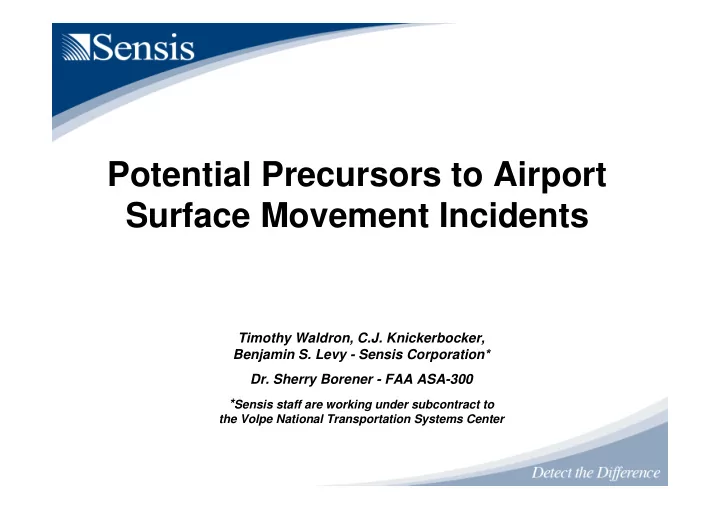

Potential Precursors to Airport Surface Movement Incidents Timothy Waldron, C.J. Knickerbocker, Benjamin S. Levy - Sensis Corporation* Dr. Sherry Borener - FAA ASA-300 * Sensis staff are working under subcontract to the Volpe National Transportation Systems Center
Study Background and Goals � Airport Surface Safety remains a serious concern – Runway incursions and excursions – Ramp and taxiway activity � Airport Surface Detection Equipment – Model X (ASDE-X) (FAA’s A-SMGCS system, now operational at 20+ US airports) shows airport activity in new detail � Specific problem: Combine ASDE-X surveillance with other data sources to make case for operational benefits of cockpit displays such as CDTI (Cockpit Display of Traffic Information) � Presentation describes study approach and preliminary results �
Movement Anomalies: Events and Patterns Event/Pattern Name Potential relevance to enhanced and Characteristics cockpit displays Sudden Stop Possible symptom of disorientation (for Deceleration that is stronger than usual example, abrupt stop at hold line) or for aircraft activity and conditions limited awareness of relevant traffic (event) Irregular Turn Exclude “hesitation” that represents Hesitation or overshoot at intersection yield of right of way to traffic (event) Route Excursion Depends on ability to characterize Sustained departure from normal path normal path and discount routine (event) alterations Slow Taxi Exclude holds and intervals when Low average speed while moving closely following traffic (pattern) �
Using Acceleration Estimates to Classify Maneuvers � Surveillance sets LONGITUDINAL (ALIGNED�WITH�VELOCITY) bounds on accuracy of estimated velocity and acceleration SPEED � Use simple visual UP TURNING TURNING scale to classify maneuvers STOP�or� STEADY CREEP � Sensitivity thresholds LATERAL can be adjusted for SLOW�& SLOW�& SLOWING accuracy and type of TURN TURN event analyzed VELOCITY�VECTOR ACCELERATION�VECTOR �
Analysis Process Overview Recorded� Surveillance Find�and� Characterize Movements Supplemental� Data�Sources Compare�to� Expected� Behavior Detect Potential� Anomalies Analyze Anomalies in�Context Evaluate Significance Report Statistics�&� Excerpts �
Overview of ASDE-X System � Core mission of ASDE-X is to improve safety by giving ATCT: - Complete real-time description of all airport traffic in coverage: movement area, ~5 nmi of approach, optionally ramp area - Conflict alerts from Safety Logic � ASDE-X data is the primary information source for this study �
Types of Supplementary Information Information Class Sources and Relevance to Study Object Properties Aircraft registry (owner, aircraft type, (invariant attributes of airport objects) dimensions, wake class) Airport vehicle list Environmental conditions Weather affects visibility, surface friction, Weather workload, landing and takeoff parameters Surface friction Visibility Weather-driven effects Airport configuration (such as temporary closures) may cause Congestion clusters of anomalies Planning information Schedule Flight plan transactions Flow restrictions Operations practices ATCT procedures Standard taxi routes Ramp procedures Surface restrictions (weight, size) Airline procedures De-icing locations Preferred sequencing �
Information Sources �
Sudden Stop With or Without Nearby Traffic RUNWAY RUNWAY Possible Causes: Unaware of Hold Location STRONG Uncertain of Clearance BRAKING STRONG Avoiding Conflict BRAKING (own error or other party’s) TAXIWAY TAXIWAY � Objective: Detect episodes of unusually strong braking for situation � Purpose: Quantify instances of pilot confusion or error that CDTI could prevent � Benefits: Reduce fuel use and potentially maintenance costs; improve overall flow �
Irregular Turn TAXIWAY TAXIWAY Possible Causes: HESITATION OVERSHOOT Possible Causes: Uncertain about Location Uncertain about Location Uncertain about Route Uncertain about Route Avoiding Obstruction Avoiding Conflict Wary of Unseen Traffic TAXIWAY TAXIWAY � Objective: Detect irregular taxi turn (hesitation, overshoot, reversal); relate to possible causes (complexity of surface geometry, changes from usual routes) � Purpose: Quantify instances of CDTI-preventable pilot confusion or error � Benefits: Reduced taxi time, improved flow ��
Route Excursion � Route Excursion defined as sustained deviation from assigned or intended spatial route on airport surface � Challenge: Finding excursions without electronic record of assigned routes � Approach: Analyze route frequency and causes for planned unusual routes ��
Simplified Motion Classification Rules Sample V XY |A XY | | Θ AV | A long Description m/s m/s 2 deg m/s 2 Stopped or < 0.5 any any any creeping ≥ 0.5 Steady < 0.5 any any ≥ 0.5 ≥ 0.5 Speed up < 30 any ≥ 0.5 ≥ 0.5 Slow down > 150 any ≥ 0.5 ≥ 0.5 ≥ -0.5 Turning 30-150 ≥ 0.5 ≥ 0.5 Turning & 30-150 < -0.5 slowing ��
Review Maneuver Classification LONGITUDINAL (ALIGNED�WITH�VELOCITY) SPEED UP TURNING TURNING STOP�or� STEADY CREEP LATERAL SLOW�& SLOW�& SLOWING TURN TURN VELOCITY�VECTOR ACCELERATION�VECTOR ��
Example of Landing and Taxi-in stop/creep steady speedup slowing turning turnslow ��
Example of Landing and Taxi-in Landing Deceleration (CRJ2) Landing and Taxi-In (CRJ2) 70 stop/creep 0.5 steady 60 speedup 0 slowing 50 turning Acceleration (m/s2) -0.5 turnslow Speed (m/s) 40 -1 -1.5 30 Slow for intersection -2 20 -2.5 10 -3 0 -3.5 50 100 150 200 250 300 350 110 120 130 140 150 Time (sec) Time (sec) Speed and acceleration profile use same maneuver color-coding Example indicates resolution achieved via post-processing (preliminary) ��
Example of Taxi-Out with Holds Taxi-Out with Holds (CRJ2) 10 stop/creep 9 steady speedup 8 slowing turning 7 turnslow Speed (m/s) 6 5 4 3 2 1 0 0 100 200 300 400 500 600 Time (sec) ��
Path of Surface Vehicle Example of Vehicle Maneuvers 800 stop/creep 700 steady speedup 600 slowing turning 500 turnslow Y Position (m) 400 300 200 100 0 -100 strong braking -200 1200 1400 1600 1800 2000 2200 X Position (m) ��
Vehicle Braking Event Vehicle Speed History (detail) 25 stop/creep steady speedup 20 slowing turning turnslow Speed (m/s) 15 strong braking 10 hold 5 0 560 580 600 620 640 660 Time (sec) ��
Variations on Departure Route (2) ��
Potential Use of Maneuver-Based Cost Functions Using Events in Consumption Estimate 10 9 Departure 8 7 Discrete penalty at end of holds Speed (m/s) 6 5 Hold rate 4 3 Taxi rate 2 1 Taxi rate 0 0 100 200 300 400 500 600 Time (sec) ��
Questions Thank You! Sherry.Borener@faa.gov (202) 493-5630 Timothy.Waldron@sensis.com (315) 445-5826 ��
Recommend
More recommend